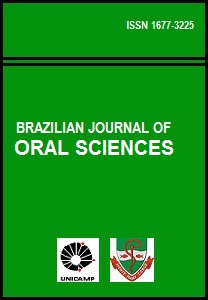Abstract
Aim: To evaluate the leakage on Er,Cr:YSGG laser- and bur- prepared Class V cavities restored with a silorane-based composite resin using different insertion techniques Methods: 40 cavities were outlined according to: the type of instrument [Er,Cr:YSGG laser (3.0 W power, energy per pulse of 150 mJ, fluence of 53.57J/cm2 , pulse duration of 140-200 µs, 20 Hz repetition rate and 55/65% air/water spray) or diamond bur]; and the type of filling technique (bulk increment or incremental). Four experimental groups were obtained (n=10): G1- diamond bur (DB) and incremental (I); G2- DB and bulk increment (BI); G3- Er,Cr:YSGG and I; and G4- Er,Cr:YSGG and BI. Specimens were restored with a silorane-based composite resin (Filtek P90, 3M/ESPE), subjected to 500 thermal cycles, sealed, infiltrated with 2% (w/v) methylene blue and sectioned in halves. Specimen analysis was scored based on a scale. Statistical analyses were done using the Kruskal-Wallis and Student Newman-Keuls tests (α=0.05). Results: Statistically significant differences were observed between G2 and G4 (p=0.003) and between G1 and G2 (p=0.028). The filling technique did not influence the pattern of dye leakage in the cavity walls (p=0.151). Conclusions: Less leakage was observed when Er,Cr:YSGG cavities were restored with silorane-based composite resin, using the bulk increment technique. Nevertheless, cavities done using diamond bur have less leakage only when incrementally restored.
This work is licensed under a Creative Commons Attribution 4.0 International License.
Copyright (c) 2015 Fernanda Strohmayer Sarabia, Andréa Dias Neves Lago, Sérgio Brossi Botta, Cynthia Soares de Azevedo, Narciso Garone-Netto, Adriana Bona Matos
Downloads
Download data is not yet available.

